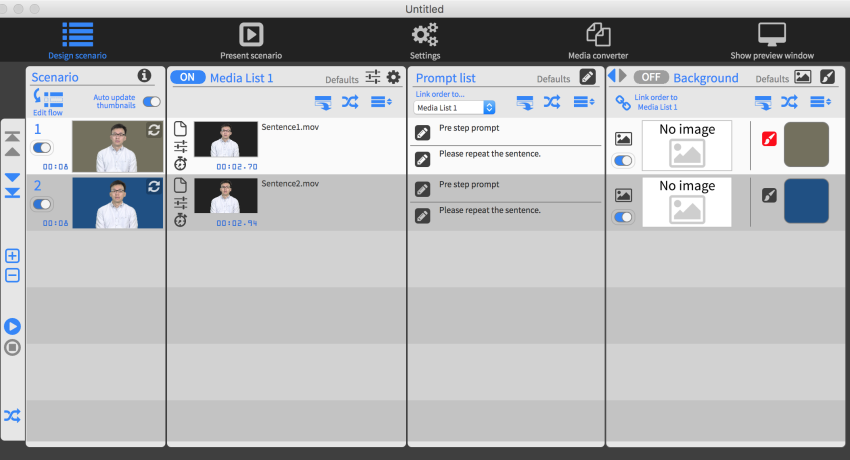Scenario Designer is a tool to build, deliver, and score multistep tests that can incorporate audio, video, images and text prompts. Scenario Designer can use almost any kind of audio or video, but it also supports libraries of media that include features that open up additional possibilities. Using Scenario Designer you can quickly create test scenarios, save them for later use, and deliver the test to subjects.
Originally designed for the University of Maryland Department of Hearing and Speech Sciences as a tool to research various aspects of human hearing and perception, Scenario Designer can be used in any setting where a sequence of media prompts followed by a text question is required.
Sandra Gordon-Salant, Ph.D. is Professor and Director of the Doctoral Program in Clinical Audiology in the University of Maryland Department of Hearing and Speech Sciences (HESP). Dr. Gordon-Salant approached the NFLC Department of Art and Media Production (AMP) to produce videos for her research on the effects of aging and hearing loss on auditory processes.
In the process of working with Dr. Gordon-Salant on the video production, the AMP team realized that HESP's planned method of delivery was very labor intensive and inflexible. NFLC-AMP proposed developing software that would speed the development and delivery of hearing tests. Scenario Designer was the result of that initiative. Funding was provided by the National Institutes of Health.
Scenario Designer lets you build Scenarios with the following features...
- One Media List that controls the timing of the Scenario and is used for scoring
- Three supplementary Media Lists
- A list of images
- A list of background colors
- A list of instructional prompts
- Optional pre- and post-test instructional prompts
- Flexible timing parameters
The University of Maryland Scenario Designer Media Libraries contain videos of people speaking carefully selected libraries of words and sentences that are useful in various kinds of research. The Library videos were recorded in a green screen studio, and the audio has been carefully leveled to standard RMS values. While these Libraries can be utilized with most video editing software, additional features can be accessed when used with the University of Maryland’s Scenario Designer app.
The Harvard Sentences Media Libraries
The Harvard Sentences (or the IEEE Recommended Practices for Speech Quality Measurements) have been used in audio only formats for decades for testing of voice over IP, cellular, and telephone systems. Having this recognized testing standard captured on video makes it available for research in situations where both audio and video content is important. Six Harvard Sentence Libraries are available — three capturing male native speakers of English and three capturing male native speakers of Spanish reading all 720 sentences. When used in concert with the Scenario Designer app, additional features of the Libraries become accessible including live compositing of the speaker over various backgrounds, a search interface for specific words, variable AV asynchrony (±450ms in 50ms increments), and a Library specific interface for scoring responses.
The Monosyllabic CVC Media Libraries
The Monosyllabic CVC Media Libraries contain one-syllable (monosyllabic) words of the consonant-vowel-consonant (CVC) type that sample a listener's accuracy in recognizing vowel phonemes and individual consonant phonemes in initial and final positions of a word. Within each Library, every consonant in the English language appears in both initial and final positions multiple times, excluding those consonants that only appear in English in one position or the other. Six Monosyllabic CVC Media Libraries are available — three capturing male native speakers of English and three capturing male native speakers of Spanish reading a list of 160 Monosyllabic CVC words. When used in concert with the Scenario Designer app, additional features of the Libraries become accessible including live compositing of the speaker over various backgrounds, a search interface for specific words, variable AV asynchrony (±450ms in 50ms increments), and a Library specific interface for scoring responses.













